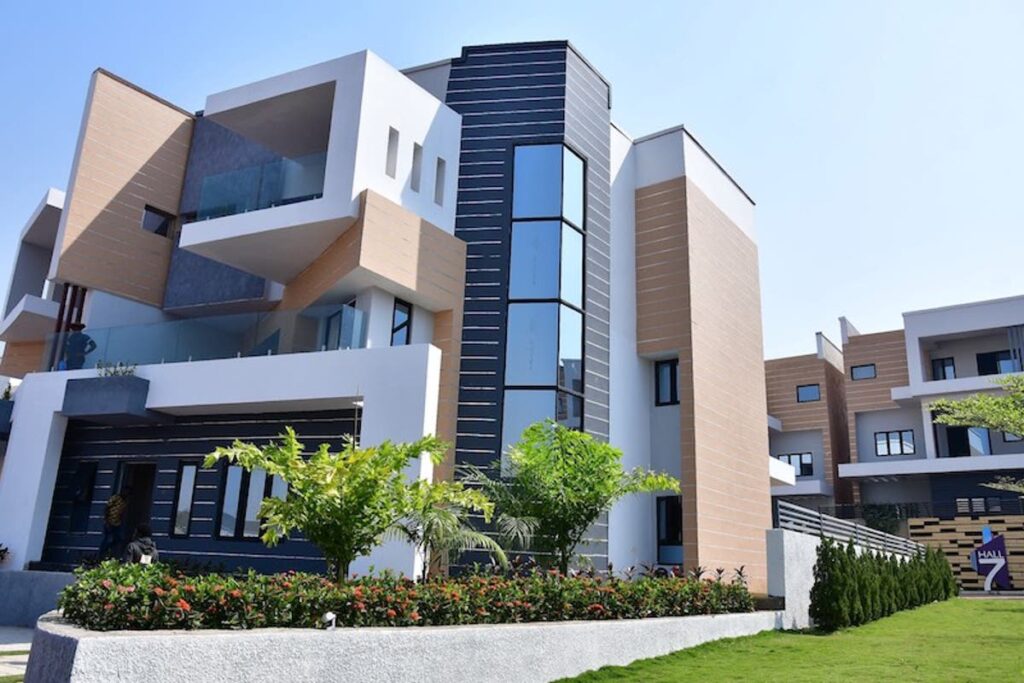72% of young Nigerians are interested in owning a house but cite fund, fraud, and access to innovative products as challenges

The Issue
After a boom period marked by high oil prices and double-digit growth a decade ago, the Nigerian real estate sector was significantly impacted by the country’s economic downturn, as industry growth dropped off and remained subdued in 2017 and early 2018. As a developing country, the real estate sector has evolved at a tremendous pace, even while other budding sectors such as telecommunications, agriculture, power, tourism have provided a veritable platform for the sector to thrive. Over the years, developers are increasingly turning their attention towards smaller and more affordable projects, which should benefit from ongoing government efforts to grow the country’s mortgage market and reduce its housing deficit.
In 2019, the head of the Federal Mortgage Bank, Ahmed Dangiwa, placed Nigeria’s housing deficit at 22 million units; and the bulk of that is in urban areas — Lagos, Port Harcourt, and Abuja. According to real estate expert and chairman, the organising committee of the Real Estate & Construction Expo, Dr. Somadina Anene, “If concerted efforts are not urgently put in place to address Nigeria’s housing deficit, which has continued to increase astronomically, it may grow to 25 million in 2021”. According to Anene, the housing deficit, which stood at 17 million about four years ago, can be traced to difficulties such as a cumbersome land administration system, high cost of building materials, rising poverty, high interest rate on loans, among others.
The Millennium Development Goal (MDG), which also focused on reducing poverty through house ownership, expired in 2015. However, Nigeria has failed to achieve 10% of the requirement, mainly for the low and medium-income group where demand remains critical. Several federal administrations have promised ‘Houses for All’ by 2000, shifted to 2010, 2015, and now 2020. None of these was achieved, even as more federal and state governments have embarked on housing schemes for their workers. Finally, the Federal Government admitted it could not provide houses for all Nigerians due to workers’ attitude to government-owned properties and the high annual maintenance cost. Instead, it sold all the houses previously constructed for public servants to members as owner-occupiers. It monetised housing provision to housing allowance to workers while deducting 2.5% of salaries for housing.
However, it has also been observed that houses built by the Federal Housing Authority (FHA) are beyond the reach of the average worker. Available prices of FHA houses indicate that a 2-bedroom flat can go for as much as N9m to N23m, which are way beyond the reach of the average low/medium income earners. Similarly, there are many completed houses built by FHA and private developers in Lagos and Abuja that remain unoccupied due to the asking prices. Essentially, this reflects how government agencies and private companies can form policies to assist young Nigerians to own a home. Employers can invest in certain estates to accommodate their employees throughout their employment, with deductions made from their salaries even if they leave the company. However, challenges facing the sector have hampered it from realising its true potential. At the same time, prevailing macroeconomic conditions continue to offer a silver lining to residential and office tenants.
The Question
As a developing country, Nigeria’s real estate sector is evolving at a tremendous pace. Several real estate experts identified 2019 as an excellent year for Nigeria’s housing market, with demand rising by double-digit figures. The shortage of housing at all levels is severe. Worse, the prospect of young Nigerians also owning houses wanes speedily due to harsh economic conditions, which have affected many businesses. With the minimum wage of about $80 a month, and graduates earning an average of N80,000 ($222) a month, renting in urban cities can be an expensive exercise. The purchasing power of young people has remained low due to the high inflation rate, which has gotten worse among those aged 20 – 34 years. There has also been a drop in the proportion of homeownership from 51% in 1991 to only 24% in 2016.
For millions of young professionals, home ownership can be a challenge in urban mega-cities, as ‘mid-to-high-income’ housing can cost between $5,000 and $40,000 a year. For context, the average rent for an apartment in Manhattan, New York is as high as $4,336 per month, or $52,032 per year, and about 97% of apartments in the borough rent for more than $2,000 per month. A recent report also identified a gap in knowledge between the requirement for housing and the ability to obtain the preferred housing type, which affects demand for affordable housing.
While some households can achieve affordability with supplementary, informal income, this is not counted in loan origination procedures. This affordability analysis also shows that low-income earners can afford housing units at N2m ($13,333.33), and such analysis of dwelling units helps to understand affordability. If such knowledge can help improve housing demand, it can, arguably, reduce homelessness and the desperate demand to get anything sufficient. Therefore, Culture Intelligence from RED asked its national focus group about their experiences in securing housing, improving ownership, and other factors that could motivate them to become involved.
While some households can achieve affordability with supplementary, informal income, this is not counted in loan origination procedures. This affordability analysis also shows that low-income earners can afford housing units at N2m ($13,333.33), and such analysis of dwelling units helps to understand affordability. If such knowledge can help improve housing demand, it can, arguably, reduce homelessness and the desperate demand to get anything sufficient. Therefore, Culture Intelligence from RED asked its national focus group about their experiences in securing housing, improving ownership, and other factors that could motivate them to become involved.
What The Streets Are Saying
Among the focus group, 41.7% were between 18 – 25 years, 33.3% were between 26 – 35 years, while 25% were between 36 – 45 years old. About 33% earned between N150,000 – N200,000; 33.3% earned between N200,000 – N300,000; 16% between N80,000 – N150,000 while 8% earned N500,000 and above. On if they are interested in owning a home or investing in real estate, 66.7% said ‘yes’, 16.7% said ‘maybe’, and the rest replied ‘no’.
The three significant factors selected by the focus group that would motivate them to invest in real estate include access to funds, innovative products, and brand trust. Others include word-of-mouth and, lastly, relatable marketing (with language and platforms that directly address their needs).
Based on an analysis, home ownership could be extended to more than 50% of the population if homes were built for those with an annual income of N340,000, or about US$2,000. Incremental building and cooperatives could meet the needs of another 25% of the market. The construction sector is also currently unable to meet this demand due to several weaknesses, such as lack of skills at all levels, weak organisational capacity, lack of access to finance, and lack of standardisation of building plans and materials.
“Previously, the minister of Works and Housing, Babatunde Fashola, explained that there is no low-cost building material, so the country cannot successfully maintain low-cost housing,” said an expert who also led marketing for a real estate company. “But that does not account for low-cost designs and scale, and the marketing strategy has to improve. First, apart from the government housing, private organisations have to commit to invest in low-cost housing willfully. Secondly, there has to be targeted marketing that explains the accessibility and procedures for getting them. Unfortunately, millions of young Nigerians are turned off when they hear the millions of naira they have to make as an initial payment”.
The housing deficit in Nigeria has often been misdiagnosed as a cost rather than an affordability problem, and there are deep beliefs that houses in Nigeria are expensive. Furthermore, the mortgage market cannot provide sustainable long-term loans to borrowers due to a lack of access to long-term funds. A survey by the Central Bank of Nigeria (CBN) in 2012 revealed that financial institutions described this as the number one obstacle preventing the growth of the mortgage market, ahead of foreclosure, housing supply, and the cost of title registration.
“The housing and ownership opportunities for young Nigerians are minimal, and the rising inflation is not making things easier,” said an expert. “With the constant increase of unemployment and cost of living, it is difficult for more young people to invest or even think about owning a home. For example, Lagos is home to 22 million people and counting, more than double those in New York and London combined. However, an estimated two-thirds live in face-me-I-face-you buildings, slums, and crowded shanties. There are real estate opportunities for such a large population, but the most crucial factor that needs to be addressed is poverty among young Nigerians”.
Housing and infrastructure investment have been strongly linked to economic growth. An increase in housing production, especially at the lower reaches of the market, will amplify job creation, both skilled and unskilled. While the availability of housing finance is essential for increasing housing production, sustainable, and equitable housing production also depends on legal protections, access to residential lands and essential services, an efficient and transparent land administration and a macroeconomic environment that maintains low inflation and low-interest rates.
Insights on What The Streets Are Saying are drawn from data collected through in-depth interviews and surveys with our 500-member consumer panel spread across the country, including 100 culture insiders, who are all leading thinkers and doers across media and marketing.

